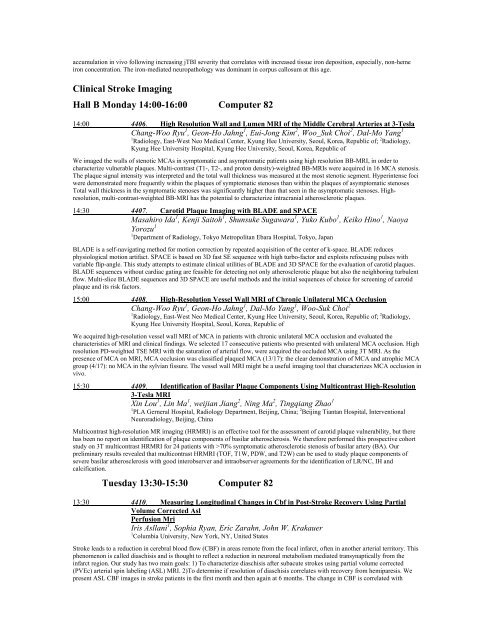Electronic Posters: Neuroimaging - ismrm
Electronic Posters: Neuroimaging - ismrm
Electronic Posters: Neuroimaging - ismrm
You also want an ePaper? Increase the reach of your titles
YUMPU automatically turns print PDFs into web optimized ePapers that Google loves.
accumulation in vivo following increasing jTBI severity that correlates with increased tissue iron deposition, especially, non-heme<br />
iron concentration. The iron-mediated neuropathology was dominant in corpus callosum at this age.<br />
Clinical Stroke Imaging<br />
Hall B Monday 14:00-16:00 Computer 82<br />
14:00 4406. High Resolution Wall and Lumen MRI of the Middle Cerebral Arteries at 3-Tesla<br />
Chang-Woo Ryu 1 , Geon-Ho Jahng 1 , Eui-Jong Kim 2 , Woo_Suk Choi 2 , Dal-Mo Yang 1<br />
1 Radiology, East-West Neo Medical Center, Kyung Hee University, Seoul, Korea, Republic of; 2 Radiology,<br />
Kyung Hee University Hospital, Kyung Hee University, Seoul, Korea, Republic of<br />
We imaged the walls of stenotic MCAs in symptomatic and asymptomatic patients using high resolution BB-MRI, in order to<br />
characterize vulnerable plaques. Multi-contrast (T1-, T2-, and proton density)-weighted BB-MRIs were acquired in 16 MCA stenosis.<br />
The plaque signal intensity was interpreted and the total wall thickness was measured at the most stenotic segment. Hyperintense foci<br />
were demonstrated more frequently within the plaques of symptomatic stenoses than within the plaques of asymptomatic stenoses<br />
Total wall thickness in the symptomatic stenoses was significantly higher than that seen in the asymptomatic stenoses. Highresolution,<br />
multi-contrast-weighted BB-MRI has the potential to characterize intracranial atherosclerotic plaques.<br />
14:30 4407. Carotid Plaque Imaging with BLADE and SPACE<br />
Masahiro Ida 1 , Kenji Saitoh 1 , Shunsuke Sugawara 1 , Yuko Kubo 1 , Keiko Hino 1 , Naoya<br />
Yorozu 1<br />
1 Department of Radiology, Tokyo Metropolitan Ebara Hospital, Tokyo, Japan<br />
BLADE is a self-navigating method for motion correction by repeated acquisition of the center of k-space. BLADE reduces<br />
physiological motion artifact. SPACE is based on 3D fast SE sequence with high turbo-factor and exploits refocusing pulses with<br />
variable flip-angle. This study attempts to estimate clinical utilities of BLADE and 3D SPACE for the evaluation of carotid plaques.<br />
BLADE sequences without cardiac gating are feasible for detecting not only atherosclerotic plaque but also the neighboring turbulent<br />
flow. Multi-slice BLADE sequences and 3D SPACE are useful methods and the initial sequences of choice for screening of carotid<br />
plaque and its risk factors.<br />
15:00 4408. High-Resolution Vessel Wall MRI of Chronic Unilateral MCA Occlusion<br />
Chang-Woo Ryu 1 , Geon-Ho Jahng 1 , Dal-Mo Yang 1 , Woo-Suk Choi 2<br />
1 Radiology, East-West Neo Medical Center, Kyung Hee University, Seoul, Korea, Republic of; 2 Radiology,<br />
Kyung Hee University Hospital, Seoul, Korea, Republic of<br />
We acquired high-resolution vessel wall MRI of MCA in patients with chronic unilateral MCA occlusion and evaluated the<br />
characteristics of MRI and clinical findings. We selected 17 consecutive patients who presented with unilateral MCA occlusion. High<br />
resolution PD-weighted TSE MRI with the saturation of arterial flow, were acquired the occluded MCA using 3T MRI. As the<br />
presence of MCA on MRI, MCA occlusion was classified plaqued MCA (13/17): the clear demonstration of MCA and atrophic MCA<br />
group (4/17): no MCA in the sylvian fissure. The vessel wall MRI might be a useful imaging tool that characterizes MCA occlusion in<br />
vivo.<br />
15:30 4409. Identification of Basilar Plaque Components Using Multicontrast High-Resolution<br />
3-Tesla MRI<br />
Xin Lou 1 , Lin Ma 1 , weijian Jiang 2 , Ning Ma 2 , Tingqiang Zhao 1<br />
1 PLA Gerneral Hospital, Radiology Department, Beijing, China; 2 Beijing Tiantan Hospital, Interventional<br />
Neuroradiology, Beijing, China<br />
Multicontrast high-resolution MR imaging (HRMRI) is an effective tool for the assessment of carotid plaque vulnerability, but there<br />
has been no report on identification of plaque components of basilar atherosclerosis. We therefore performed this prospective cohort<br />
study on 3T multicontrast HRMRI for 24 patients with >70% symptomatic atherosclerotic stenosis of basilar artery (BA). Our<br />
preliminary results revealed that multicontrast HRMRI (TOF, T1W, PDW, and T2W) can be used to study plaque components of<br />
severe basilar atherosclerosis with good interobserver and intraobserver agreements for the identification of LR/NC, IH and<br />
calcification.<br />
Tuesday 13:30-15:30 Computer 82<br />
13:30 4410. Measuring Longitudinal Changes in Cbf in Post-Stroke Recovery Using Partial<br />
Volume Corrected Asl<br />
Perfusion Mri<br />
Iris Asllani 1 , Sophia Ryan, Eric Zarahn, John W. Krakauer<br />
1 Columbia University, New York, NY, United States<br />
Stroke leads to a reduction in cerebral blood flow (CBF) in areas remote from the focal infarct, often in another arterial territory. This<br />
phenomenon is called diaschisis and is thought to reflect a reduction in neuronal metabolism mediated transynaptically from the<br />
infarct region. Our study has two main goals: 1) To characterize diaschisis after subacute strokes using partial volume corrected<br />
(PVEc) arterial spin labeling (ASL) MRI. 2)To determine if resolution of diaschisis correlates with recovery from hemiparesis. We<br />
present ASL CBF images in stroke patients in the first month and then again at 6 months. The change in CBF is correlated with
















